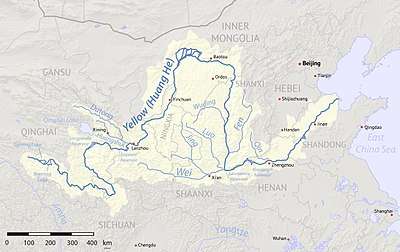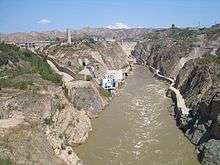Along the Yellow River
The Yellow River (黄河 Huang He) is one of China's great rivers and a historic transport route. It is not as important a tourist route as the Yangtze further south, but might be of interest to some.
- This article is an itinerary.
The Yellow River is not tame. Only parts of it are navigable; other sections have quite a rapid current. It has had many disastrous floods; irrigation and flood control projects have been going on in the area for several thousand years and have never achieved complete success.
Understand
Chinese civilization first developed along the Yellow River; the Shang Dynasty ruled a region around the river from 1700 BCE. The Zhou Dynasty, 1027-221 BCE, expanded the empire into other regions like the lower Yangtze (Chang Jiang) basin.
The provinces of Hebei and Henan take their names from this river. "He" is "river, "bei" and "nan" are "north" and "south" respectively.
Cities

The river rises in Qinghai in the foothills of the Himalayas and runs north to Inner Mongolia. There it runs in a big arc, with the Great Wall following it for some distance, before turning east toward the sea.
Cities on its route, listed from source to coast:
- Xining, capital of Qinghai
- Lanzhou, capital of Gansu
- Yinchuan, capital of Ningxia
- Wuhai, in a strategic position controlling a pass
- Baotou, largest city in Inner Mongolia
- the capital, Hohhot, is near the river but not on it
- The great city of Xi'an is off the main river course, on a tributary
- Sanmenxia, strategic city between Wei valley and North China Plains, where Taoism was founded
- Zhengzhou, capital of Henan
- Kaifeng, historical capital of the Song dynasty
- Jinan, capital of Shandong, is just up the river from the coast
Of course there are many smaller towns as well.
Over the centuries the river has changed its course several times; the last change in 1853 moved the mouth the length of Shandong province. Today the part of the river below Jinan runs northeast and reaches the sea north of the Shandong peninsula; until 1853 it ran southeast and reached the sea on the other side of the peninsula, well south of Qingdao.
Prepare

Much of the area is not touristy. If you do not speak Chinese, you will need a least a phrasebook, preferably a bilingual guide. If possible, learn some Chinese before setting out.
Go
There are trains throughout the area. All the trains to western China (Xinjiang, Qinghai, Gansu) go through Lanzhou, which lies on the banks of the Yellow River. The Beijing-Lanzhou "north route" follows the Yellow River for half of its way. The train from Beijing to Tibet via Qinghai passes through several of the cities along the river. There are also boats along some parts of the river.
However, for flexibility if you want to follow the Yellow River, you would need to travel largely by road. Rich travelers might rent a car and driver, see Driving in China. Others would use buses, varied perhaps with train or boat for some sections.
Stay safe
General precautions against common scams and pickpockets are advisable anywhere in China.
Go next
From the inland end of this route, you could turn west onto the Silk Road (Lanzhou is on the main route), turn southeast to reach Xi'an, or go a little west to Golmud which is a jumping off point for Tibet.
At the coast end, Beijing is nearby to the north. Going south, Shanghai via Suzhou would be the obvious route but there are many other choices.